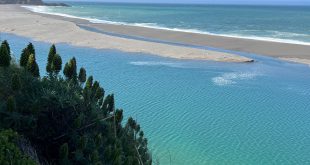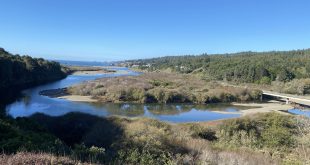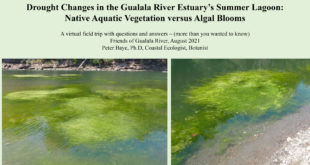On May 16, 2024, the California Coastal Commission issued a permit to Bower Limited Partnership for replacement of the failed retaining wall behind the Surf Market and directly above the Gualala River estuary.
The Surf Market building was built too close to the bluff edge in 1983, in violation of coastal development permit CDP No. NCR-80-P-75, which is why the developer needed a retaining wall, even though that wall had to be constructed without legally required minimum setback from the environmentally sensitive habitat area (ESHA) of the Gualala River estuary — see Permit History, below.
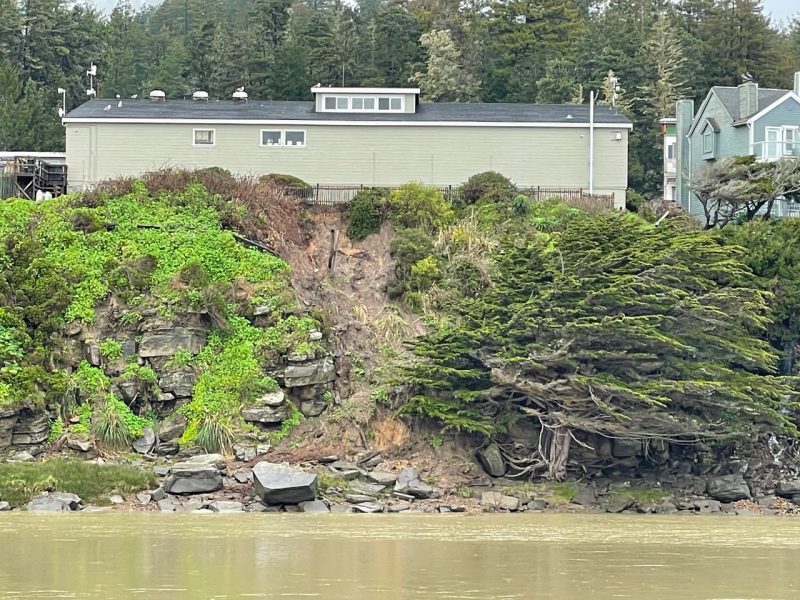
Environmental Issues
Construction of the proposed wall would disturb existing native vegetation and soil, making it vulnerable to increased invasion and dominance by non-native plants, reducing native biological diversity.
Construction would disrupt public access to a portion of the Gualala Bluff Trail, which was built by, and is maintained by, the Redwood Coast Land Conservancy.
The runoff of polluted stormwater from the parking lots, buildings, gas stations, and roads in the downtown area needs to be managed to avoid pollution entering the environmentally sensitive Gualala River estuary and to avoid runoff causing more shallow landslides of the unconsolidated fill.
The new permit requires “soil stabilization and drainage improvement plans prepared in consultation with the Redwood Coast Land Conservancy, the Dorothy King Young Chapter of the California Native Plant Society, and the Mendocino Coast Cooperative Weed Management Area. . . [and] shall include inline drains to capture runoff from the parcel that flows towards the bluff and an on-site infiltration interceptor to capture any pollutants contained in the run-off. The system shall be designed to treat or filter stormwater runoff from each storm, up to and including the 85th percentile, 24-hour storm event.” [CDP 1-83-270-A, p2]
Larger Project
The landowner is required to replace the failed retaining wall. But instead of simply doing so, in 2008 the landowner proposed a much larger and more complex 390-foot retaining wall using Geoweb (polyethylene plastic cell construction). The proposal was in two parts: a 105-foot Geoweb wall to replace the failed retaining wall, connecting to a new 285-foot Geoweb wall between the unpaved, uncompacted fill parking area and the bluff. The Coastal Commission approved the first, and determined that a de novo hearing was required to consider the second (but that hearing was never held).
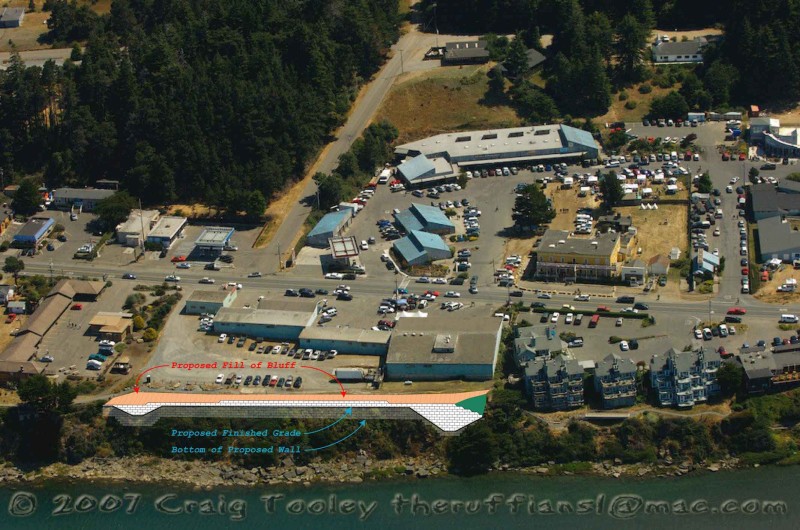
The landowner has explained publicly that this proposal is part of a larger project to demolish existing buildings, create a large paved parking lot, construct new commercial buildings and expand the Surf Supermarket on the bluff overlooking the Gualala River estuary / lagoon.
The landowner proposed to extend the bluff top by as much as 12 feet toward the Pacific Ocean by building a 390 foot long wall. Construction of the wall would obliterate the upper one third to one half of the natural bluff face. We believe that the project should fit its development to the existing property, rather than expanding the property to fit the development. Because the bluff is stable and does not need a huge retaining wall, we oppose the larger (390 foot) wall.
Permit History
(excerpted from the Adopted Findings accompanying new permit CDP 1-83-270-A)
“In 1981, the North Coast Regional Commission approved [coastal development permit] CDP NCR-80-P-75 . . . for the building of the Surf Supermarket located on the subject parcel . . .
As a condition of approval, [the permit] required recordation of an offer to dedicate a 25-foot-wide easement for public access and passive recreation along the bluff [now known as the Gualala Bluff Trail]. John J. and Ida L. Bower recorded the offers to dedicate required by the permit and the Commission issued the CDP for the construction of Surf Supermarket. . .
[The permit] specified that the supermarket building would be set back 35 feet at its northwest corner and 55 feet at its southwest corner from the bluff edge. However, when the building was constructed in the early 1980s, the structure was constructed such that the southwest corner is set back only 24 feet from the bluff edge. Thus, the constructed building was therefore placed directly within the area offered for public access along the bluff constituting a violation of [the permit].In an effort to protect the public access required by [the permit], the Commission subsequently approved CDP 1-83-270 authorizing a 120-foot-long wood retaining wall west of the market along the edge of the bluff . . . Special Condition No. 1 of [that permit] requires that the retaining wall be maintained for the life of the development on the site.
To comply with Special Condition No. 1 of CDP No. 1-83-270, the subject coastal development permit amendment application has been submitted to the Coastal Commission by Bower Limited Partnership to replace the failing retaining wall behind the supermarket. Specifically, the proposed amendment requests authorization to (1) replace the constructed 70-foot-long wooden retaining wall with an approximately 105-foot-long “Geoweb” retaining wall extending across the subject property with an approximately 30-foot-long concrete block end wall at the southern end of the retaining wall, (2) install 118 linear feet of 12-inch storm drain with a storm drain manhole, and (3) replace an existing underground septic tank.
In a related action, the applicant proposes to extend the replacement retaining wall that is proposed under Permit Amendment 1-83-270-A to the north across the top of the bluff face of APN 145-261-13 within the area of Mendocino County’s coastal permit jurisdiction. The portion of the wall proposed on APN 145-261-13 is the subject of related Appeal No. A-1-MEN-05-015, an appeal of the decision of Mendocino County to grant local CDP Permit No. 55-2006 for construction of this portion of the retaining wall. . .
On April 11, 2008, the Coastal Commission found that the appeal of the County’s approval of Permit No. 55-2006 raised a substantial issue with respect to the grounds on which the appeal was filed, pursuant to Section 30625 of the Coastal Act and Section 13115 of Title 14 of the California Code of Regulations. As a result, the County’s approval is no longer effective, and the Commission must consider the project de novo. The Commission has not yet acted on the project de novo.”
California Coastal Commission documents:
- Coastal Development Permit Amendment CDP 1-83-270-A
- Adopted Findings for CDP Amendment 1-83-270-A
- Letter from CA. Coastal Comm. to Bower Limited Partnership re: issuance of CDP 1-83-270-A
For more information:
Gualala River – Retaining wall – summary of the issue from 2006 to 2010
 Friends of Gualala River Protecting the Gualala River watershed and the species living within it
Friends of Gualala River Protecting the Gualala River watershed and the species living within it
